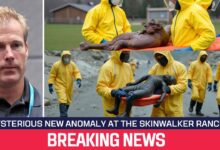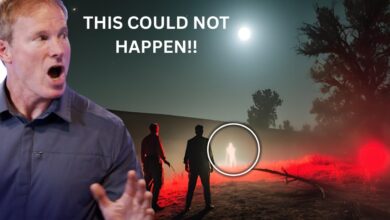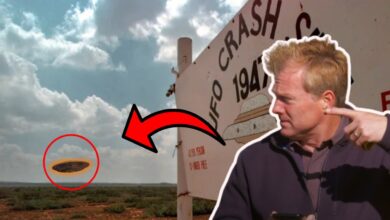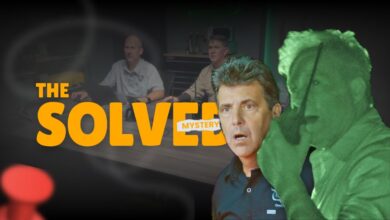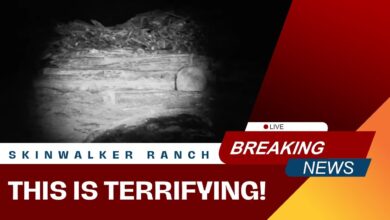Season 6 Will Change Everything we know about Skinwalker Ranch!!
Season 6 Will Change Everything we know about Skinwalker Ranch!!

The ongoing investigation into Utah’s infamous Skinwalker Ranch had already tested the limits of science, skepticism, and the human imagination.
But nothing could have prepared the team for what awaited inside the mesa. In season 6 of The Secret of Skinwalker Ranch, Dr. Travis Taylor and his crew embarked on their most ambitious operation yet, a drilling project designed to pierce the heart of the mesa and probe the anomalies that had long defied explanation.
Their objective was deceptively simple on paper: drill two parallel bore holes, each nearly 600 ft deep, to bracket a massive object first detected in earlier ground penetrating radar scans. Once complete, specialized sensors could be lowered to reveal the nature of whatever lay buried beneath layers of rock, soil, and secrecy.
But from the very first moments, the mesa made it clear that this would not be a straightforward excavation. Drill bits warped and fractured in ways that could not be explained by ordinary geology. Equipment overheated inexplicably, as if the Earth itself were resisting intrusion.
Strange readings pulsed across the team’s instruments: localized energy spikes, electromagnetic disturbances, and temperature fluctuations that defied natural patterns. Every anomaly felt alive, almost sentient, reacting to their presence and their efforts to penetrate the mesa’s interior.
Then, amid the mounting tension and mechanical failures, something extraordinary emerged. Beneath the layers of rock and sediment, the team uncovered what appeared to be evidence of a decades-old excavation, an operation deliberately concealed, leaving traces that only the combination of modern technology and dogged persistence could reveal.
Had someone already attempted to reach the same buried object long before the current team arrived? Was it part of a secret government program or something even stranger, connected to the inexplicable phenomena that have plagued Skinwalker Ranch for generations?
The drilling at the mesa was no longer simply a technical challenge. It had become a confrontation with the unknown—a journey into a place where geology, history, and possibly something beyond human comprehension intersected. Every malfunction, every energy spike, every shadow cast by the flickering lights of their equipment suggested that the mesa was not just hiding something, it was guarding it.
And as Dr. Taylor and the team pressed deeper, they realized that the mysteries of Skinwalker Ranch were not confined to legend or anecdote. They were alive, tangible, and waiting to reveal secrets that could challenge everything humanity thought it knew about the world beneath its feet.
The ongoing investigation into the mysteries of Utah’s infamous Skinwalker Ranch took a surprising and potentially historic turn when a drilling operation inside the mesa evolved from a frustrating technical challenge into an archaeological revelation.
In season 6 of The Secret of Skinwalker Ranch, Dr. Travis Taylor and the team pushed deeper into the mesa than ever before, encountering not just strange materials and seemingly impenetrable objects, but evidence suggesting a decades-old excavation hidden far beneath the surface.
The plan seemed straightforward: drill two parallel bore holes, each nearly 600 ft deep, to bracket a massive object detected in previous ground penetrating radar scans. Once the holes were complete, the team could lower scanning equipment to investigate the nature of these buried anomalies.
But from the outset, the operation defied expectations. The drills experienced bizarre malfunctions, unexplained heating events, and bit damage that seemed impossible given the conditions. The tungsten carbide teeth of the drill, engineered to slice through solid rock, were being destroyed at an alarming rate. Bits emerged with half their teeth missing. Housings fused together as if welded. Yet, instrument readings showed no extreme heat capable of causing such fusion. It was as if the material itself, or something within it, was interacting with the drill in ways that defied conventional physics.
Amid the rocky debris, fragments of ceramic began to appear, echoing discoveries from earlier digs. Some pieces bore a smooth, distinctive glaze, while others carried textures that simply did not match the natural sandstone of the mesa. A few fragments even displayed cross-hatch patterns suggestive of intentional manufacture, hinting at design rather than random geological formation.
From a scientific standpoint, the presence of ceramic hundreds of feet inside the mesa was profoundly puzzling. Ceramics require controlled, intense heat to produce, and finding them so deep suggested deliberate placement or a process far beyond current understanding. The discovery posed questions that transcended geology: Who or what placed these materials here? And more unsettling, what purpose might they serve in the heart of this enigmatic mesa?
The drill team pressed on, determined to break through the final 85 ft to the surface on the far side of the mesa. Initially, progress was rapid, nearly a foot and a half per minute, but just 35 ft from daylight, everything came to a grinding halt. Allan, the lead driller, reported that the bit had stopped cutting and was instead gliding over something unnervingly smooth.
The sound coming from the drill hinted at contact with a surface harder than sandstone, perhaps even more resilient than the ceramic-like layer they had encountered earlier. When the bit was pulled, the team’s unease deepened: more teeth were missing, the damage severe, and the drill housing had taken a pounding that conventional geology could not explain.
Ground penetrating radar had revealed not just one massive anomaly within the mesa, but several smaller ones. The leading theory became that the drill had struck one of these minor objects, likely coated in the same mysterious ceramic-like material.
The relentless destruction of expensive drill bits forced a difficult decision. Brandon Fugal, the owner of Skinwalker Ranch, ordered drilling to be suspended, not in defeat, but out of caution. If the objects buried within the mesa were of archaeological or technological significance, pulverizing them with a drill would be catastrophic.
Whatever lay beneath the surface, the team realized, could rewrite their understanding of the mesa itself, and patience now became the only viable path forward. Instead of attempting to brute-force their way through, the team opted for a more delicate approach.
They began designing a specialized camera rig that could be lowered into the bore hole, capable of visually inspecting the obstruction without risking damage. The hope was that the camera could reveal surface textures, composition clues, or even signs of artificial construction—evidence that might otherwise be lost if the drilling continued blindly.
While the camera project moved forward, archaeologist Chris Roberts turned to a more meticulous method. Using a fine mesh sifting screen, he combed through the drill spoils, carefully examining every fragment for ceramic shards or other artifacts.
Then, amidst material recovered from depths between 496 and 498 ft, Roberts made a startling discovery: a heavily worn US nickel dated 1964. At first glance, a coin might seem trivial, almost laughably mundane, but its context suggested something extraordinary. In archaeological practice, it was not uncommon to leave a coin from the year of a dig in the backfill—a subtle timestamp for future excavators to mark when the previous work occurred.
If that was indeed the purpose of this nickel, it implied that someone had conducted a deep excavation inside the mesa in or shortly after 1964, reaching nearly 500 ft, and had then carefully backfilled the site. The implications sent a ripple through the team. This wasn’t just a geological anomaly or a quirk of nature.
It was evidence of prior human activity at an astonishing depth, raising questions about who had been there, why they had gone so deep, and what they had hoped to uncover. The discovery reframed the entire operation. The mesa was no longer merely a subject of natural mystery; it had become a repository of human history, and perhaps secrets that had been deliberately concealed for decades.
As the camera rig descended into the bore hole, the team held their breath. Every frame of video could reveal new insights: surfaces smoother than any natural stone, subtle markings that hinted at manufacture, or anomalies in the layering that defied geological explanation. High-definition imaging allowed the team to capture details previously invisible, from faint striations to unusual textures, opening a window into a hidden world inside the mesa.
Meanwhile, Chris Roberts and his team continued the painstaking examination of the drill spoils. Each fragment of ceramic, each glint of metal, and every shard of stone was cataloged and analyzed. The nickel from 1964 had provided a temporal anchor, but the other discoveries hinted at a broader, more complex story—a story of human intervention, of deliberate placement, and perhaps of unknown technology or knowledge.
Speculation ran rampant. Had the earlier excavation discovered something so remarkable that it had to be concealed? Were the anomalies the result of natural phenomena, human ingenuity, or something entirely beyond contemporary understanding? And if so, why had the mesa been left undisturbed for decades, quietly guarding its secrets until the modern team returned?
With each passing day, the sense of anticipation grew. The combination of historical artifacts, unusual materials, and advanced detection technology made it clear that Skinwalker Ranch was not just a hotspot for paranormal activity—it was a site where history, science, and mystery converged. Every decision had to be deliberate. Every procedure had to balance discovery with preservation.
Brandon Fugal and Dr. Taylor both understood that they were at the threshold of something significant. What lay beneath the mesa might rewrite parts of local history, challenge scientific understanding, or reveal technologies and knowledge previously thought unattainable. But with each new revelation came more questions, more uncertainty, and a deeper appreciation for the complexity of the site.
The decision to halt destructive drilling and pivot to observational technology marked a turning point. Patience became the guiding principle. The team would rely on cameras, sensors, and careful archaeological techniques to explore what lay hidden. They would meticulously analyze each fragment of material, piece together historical records, and apply modern science to uncover truths long buried.
For the team at Skinwalker Ranch, this was more than a mission. It was a journey into a living puzzle, one that combined layers of geology, history, and human curiosity. Every anomaly, every artifact, and every observation was a step closer to understanding a mystery that had captivated researchers, skeptics, and believers for decades.
As the investigation progressed, one thing became clear: the mesa was not just a geological formation. It was a sentinel of secrets, a guardian of history, and a challenge to anyone who dared to penetrate its depths. And for Dr. Travis Taylor, Chris Roberts, Brandon Fugal, and the rest of the team, the story of Skinwalker Ranch was far from over. The secrets beneath the mesa awaited, patient and silent, ready to reveal themselves to those willing to listen, observe, and uncover them with care.
A single coin, innocuous at first glance, had transformed the narrative.
The mesa was no longer just a sight of modern scientific curiosity, but a repository of secrets, bridging the past with the present, challenging the team to uncover what had been hidden and perhaps why.
Instead of being the first to reach the Mesa’s hidden anomalies, the team may now realize they are merely the second, arriving decades after an unknown predecessor.
That revelation raises the stakes immeasurably. If someone had been here before, what did they uncover? And why has that knowledge remained hidden all this time? For the moment, the focus shifts to non-invasive investigation.
The camera inspection and meticulous analysis of drill spoils will take center stage while the team simultaneously dives into historical records, chasing leads that might link the 1964 coin to real events or projects long buried in secrecy.
What had begun as a straightforward drilling operation aimed merely at locating a buried object has evolved into a full-scale archaeological investigation driven by a tantalizing historical clue.
The worn nickel, small and unassuming, could prove to be the key to unlocking the mesa’s secrets, or at least to understanding who has ventured inside before.
For viewers of The Secret of Skinwalker Ranch, the shift from engineering challenge to archaeological detective story is a startling twist.
Season 6 has already shown that within the mesa, the line between geology, history, and the unexplained is razor thin.
If the coin truly represents a deliberate archaeological marker, then the mystery deepens. The site has been disturbed before and whatever knowledge that excavation produced has either been lost to time or deliberately concealed.
The mesa, it seems, holds stories that stretch far beyond modern exploration, waiting for those who can piece together the clues.
And the anomalies inside the mesa had persisted through the decades, almost as if the land itself were alive, guarding its secrets.
Dr. Travis Taylor often reminded his team at Skinwalker Ranch that every answer seemed to lead to more questions. But with the mesa, the questions had become almost dangerously compelling.
The evidence collected so far, the ceramic fragments, the warped drill bits, the strangely out-of-place nickel was only the beginning.
Beneath the surface, the mesa seemed to hum with a history that no one had fully understood.
Over the years, locals and researchers alike had told stories that defied explanation. Witnesses spoke of shadowy figures that flickered in and out of sight, of objects that moved as if obeying their own intelligence, and of sounds that seemed to resonate from nowhere, vibrating the very ground beneath their feet.
Some scientists chalked it up to natural electromagnetic anomalies. Others whispered of something far stranger, ancient technology, or perhaps even a portal, a dimensional passageway linking this world to another entirely.
The drilling team, now standing tens of feet above the final borehole depth, had come face to face with this mystery.
The drill bits had fought the mesa tooth and nail, only to be chewed to pieces by something harder than rock, smoother than any natural formation they had encountered.
And then came the nickel, worn, ordinary, yet profoundly out of place. Dated 1964, it hinted at a previous excavation, one carried out with precision and secrecy.
Someone had been here before, someone who had delved deep into the mesa, perhaps to uncover what lay hidden beneath layers of stone and ceramic-like material.
The implications were staggering. Who had done it? What had they found? And why had the knowledge vanished, leaving only the faintest trace in the form of a coin?
For Travis and his team, the drill was no longer merely a tool. It was a bridge into history, a connection to an unknown predecessor whose goals and perhaps warnings remained shrouded in mystery.
Every day on the mesa seemed to blur the line between science and the uncanny.
The radar data showed enormous anomalies buried within, shapes that resisted easy explanation, metallic and coded in materials that hinted at engineering far beyond human capability.
Could they be remnants of advanced civilizations or even extraterrestrial visitors? And if so, why had the Mesa chosen to keep them hidden to guard them with layers of rocks, ceramic, and perhaps even electromagnetic interference?
As the team prepared the specialized camera rig to peer into the borehole, a hush fell over the site.
They were no longer just drilling. They were stepping into an archaeological detective story, chasing the ghost of a 1964 excavation and the secrets it might have uncovered.
Every fragment examined, every historical lead followed, brought them closer to understanding the mesa’s hidden depths, but also closer to realizing that whatever lay beneath it was meant to endure, meant to remain concealed until the right eyes discovered it.
And so, beneath the relentless sun and the endless sweep of the Utah desert, the mesa held its silence.
The anomalies remained, the nickel waited, and the questions grew heavier with each passing hour.
For the team at Skinwalker Ranch, it was becoming clear that the line between geology, history, and the unexplained was not just thin. It was razor sharp, and crossing it might reveal truths no one could have imagined.
The 1964 excavation, if it had indeed taken place, might not have been mere curiosity. It could have been a covert attempt to study an artifact of unimaginable significance.
The timing was telling. The height of the Cold War had the world on edge with governments across the globe investing in unconventional science, desperate for any edge that might tip the balance of power.
At the same time, UFO sightings were surging across the United States as if the skies themselves were responding to hidden forces.
Could the Mesa have been on the radar of the highest echelons of power? For decades, locals whispered about the ranch’s uncanny residents. Mystical creatures prowled.
The shadows, they said, wolf-like beings impervious to bullets, glowing orbs that trail trespassers with an almost sentient awareness, and winged entities that vanished into thin air.
Some described portals, shimmering and impossible, opening in the air above the mesa and disgorging strange animals or craft that no human hand could have built.
Skeptics dismiss such tales as folklore. But at Skinwalker Ranch, the rules of the ordinary did not always apply. Compasses spun wildly. Radiation spiked with no discernable source, and electronic equipment often refused to function as expected.
Here, the boundary between myth and physics was not just blurred, it was fluid.
If the Mesa’s interior indeed concealed what some theorists called a space gate, then these manifestations might not be random.
They could be byproducts of a mechanism whose scale and sophistication dwarfed modern understanding, a gateway bridging our reality to dimensions that run parallel to our own.
Every flicker of movement in the shadows, every inexplicable hum in the air, could be a fleeting glimpse of these other worlds brushing against our own with a force both invisible and undeniable.
For Dr. Travis Taylor and the team, this meant approaching the mesa with a mixture of scientific rigor and wary respect.
The line between observation and intrusion was razor thin, and crossing it might reveal truths that humanity was not yet prepared to comprehend.
The 1964 nickel now takes on a significance far beyond its humble appearance.
It is more than a historical breadcrumb. It may mark the last time humans deliberately breached the mesa’s hidden defenses.
If that is true, what did they encounter that made them seal it again? Was it a matter of protecting humanity from something dangerous lurking within or shielding the artifact itself from human curiosity and ambition?
Whispers of black budget programs and secretive government initiatives add another layer of intrigue.
Some theorists suggest that sites like the Mesa have long served as clandestine laboratories where exotic materials are harvested and alien technologies reverse engineered.
Far from public scrutiny, these are not just flights of fancy. A careful look at the region’s history reveals uncanny patterns.
Spikes in radiation readings, clusters of strange sightings, unaccounted for military flyovers, and unexplained seismic disturbances often coincide with periods of drilling or excavation.
For scientists, investigators, and dreamers alike, the mesa is more than a geological formation. It is a living enigma, a place where the earth seems to conceal its secrets with deliberate intent.
Every layer of rock, every metallic anomaly, and now even a single nickel, hints at a story that has been unfolding in silence for decades.
Standing before it, one cannot help but feel the weight of history pressing down. The sense that the land itself is watching, waiting, and deciding what it will reveal and to whom.
The mesa is not just a sight of anomalies. It is a gateway to questions that stretch from the shadows of ancient history to the farthest reaches of astrophysics.
Every discovery, every strange artifact, every unexplained reading pulls investigators into a web of possibilities that challenge the very limits of understanding.
Is it the work of advanced human engineering crafted and lost to the sands of time? Or is it the mark of something beyond our world, extraterrestrial intelligence, leaving traces in a landscape that refuses to forget?
Perhaps it is something entirely natural, a force of the Earth we have yet to comprehend.
Whatever the truth, the journey to uncover it will test both technology and imagination.
If the invisible guardians of the mesa are real, whether electromagnetic distortions, temporal anomalies, or a mechanism deliberately shielding its secrets, then cracking the puzzle will demand more than drills, sensors, and cameras.
It will require a willingness to confront the possibility that our reality is only a single thread in a far larger multi-dimensional tapestry.
Each layer of rock, each metallic fragment, each unexplained phenomenon may be a clue, a message from a world beyond comprehension, waiting for those bold enough to decode it.

